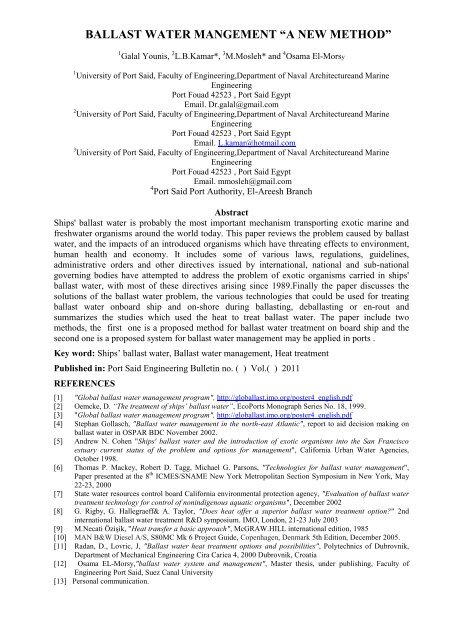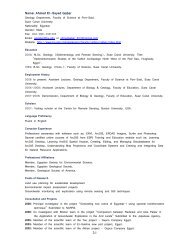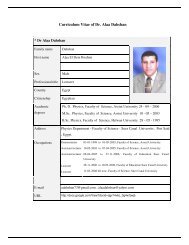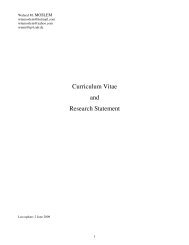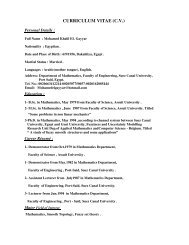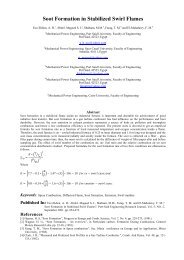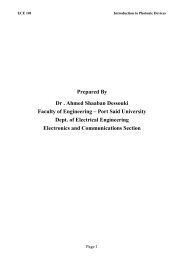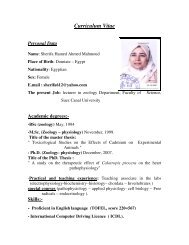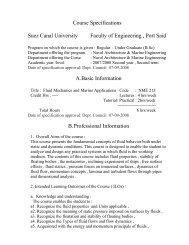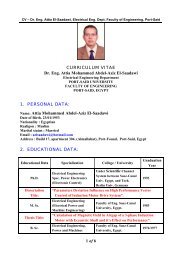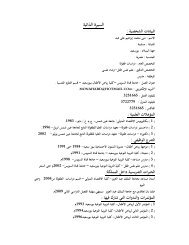BALLAST WATER MANAGEMENT
BALLAST WATER MANAGEMENT
BALLAST WATER MANAGEMENT
Create successful ePaper yourself
Turn your PDF publications into a flip-book with our unique Google optimized e-Paper software.
<strong>BALLAST</strong> <strong>WATER</strong> MANGEMENT “A NEW METHOD”<br />
1 Galal Younis, 2 L.B.Kamar*, 3 M.Mosleh* and 4 Osama El-Morsy<br />
1 University of Port Said, Faculty of Engineering,Department of Naval Architectureand Marine<br />
Engineering<br />
Port Fouad 42523 , Port Said Egypt<br />
Email. Dr.galal@gmail.com<br />
2 University of Port Said, Faculty of Engineering,Department of Naval Architectureand Marine<br />
Engineering<br />
Port Fouad 42523 , Port Said Egypt<br />
Email. L.kamar@hotmail.com<br />
3 University of Port Said, Faculty of Engineering,Department of Naval Architectureand Marine<br />
Engineering<br />
Port Fouad 42523 , Port Said Egypt<br />
Email. mmosleh@gmail.com<br />
4 Port Said Port Authority, El-Areesh Branch<br />
Abstract<br />
Ships' ballast water is probably the most important mechanism transporting exotic marine and<br />
freshwater organisms around the world today. This paper reviews the problem caused by ballast<br />
water, and the impacts of an introduced organisms which have threating effects to environment,<br />
human health and economy. It includes some of various laws, regulations, guidelines,<br />
administrative orders and other directives issued by international, national and sub-national<br />
governing bodies have attempted to address the problem of exotic organisms carried in ships'<br />
ballast water, with most of these directives arising since 1989.Finally the paper discusses the<br />
solutions of the ballast water problem, the various technologies that could be used for treating<br />
ballast water onboard ship and on-shore during ballasting, deballasting or en-rout and<br />
summarizes the studies which used the heat to treat ballast water. The paper include two<br />
methods, the first one is a proposed method for ballast water treatment on board ship and the<br />
second one is a proposed system for ballast water management may be applied in ports .<br />
Key word: Ships’ ballast water, Ballast water management, Heat treatment<br />
Published in: Port Said Engineering Bulletin no. ( ) Vol.( ) 2011<br />
REFERENCES<br />
[1] "Global ballast water management program", http://globallast.imo.org/poster4_english.pdf<br />
[2] Oemcke, D. “The treatment of ships’ ballast water”, EcoPorts Monograph Series No. 18, 1999.<br />
[3] "Global ballast water management program", http://globallast.imo.org/poster4_english.pdf<br />
[4] Stephan Gollasch, "Ballast water management in the north-east Atlantic", report to aid decision making on<br />
ballast water in OSPAR BDC November 2002.<br />
[5] Andrew N. Cohen "Ships' ballast water and the introduction of exotic organisms into the San Francisco<br />
estuary current status of the problem and options for management", California Urban Water Agencies,<br />
October 1998.<br />
[6] Thomas P. Mackey, Robert D. Tagg, Michael G. Parsons, "Technologies for ballast water management",<br />
Paper presented at the 8 th ICMES/SNAME New York Metropolitan Section Symposium in New York, May<br />
22-23, 2000<br />
[7] State water resources control board California environmental protection agency, "Evaluation of ballast water<br />
treatment technology for control of nonindigenous aquatic organisms", December 2002<br />
[8] G. Rigby, G. Hallegraeff& A. Taylor, "Does heat offer a superior ballast water treatment option?" 2nd<br />
international ballast water treatment R&D symposium. IMO, London, 21-23 July 2003<br />
[9] M.Necati Özişik, "Heat transfer a basic approach", McGRAW.HILL international edition, 1985<br />
[10] MAN B&W Diesel A/S, S80MC Mk 6 Project Guide, Copenhagen, Denmark 5th Edition, December 2005.<br />
[11] Radan, D., Lovric, J, "Ballast water heat treatment options and possibilities", Polytechnics of Dubrovnik,<br />
Department of Mechanical Engineering Cira Carica 4, 2000 Dubrovnik, Croatia<br />
[12] Osama EL-Morsy,"ballast water system and management", Master thesis, under publishing, Faculty of<br />
Engineering Port Said, Suez Canal University<br />
[13] Personal communication.
DEVELOPMENT STRATEGY OF PORT SAID PORT<br />
AND CONTAINER TERMINAL<br />
Galal Younis*, L.B.Kamar*, and Hossam Attya+<br />
1 University of Port Said , Faculty of Engineering,Department of Naval Architectureand Marine<br />
Engineering<br />
Port Fouad 42523 , Port Said Egypt<br />
Email. Dr.galal@gmail.com<br />
2 University of Port Said , Faculty of Engineering,Department of Naval Architectureand Marine<br />
Engineering<br />
Port Fouad 42523 , Port Said Egypt<br />
Email. L.kamar@hotmail.com<br />
3 Suez Canal Containers Terminal(SCCT)<br />
East of Port Said , Egypt<br />
Abstract<br />
Since 1960 until now, there is a growing trend for utilizing containers in marine shipping due to<br />
growing in global trade, safety of containers, faster handling in ports and door to door services.<br />
This trend leads to a development of container ships from 1000 TEU to 12000 TEU capacities.<br />
Consequently there is a continuous development in all related parties to container shipping such<br />
as port authorities, container terminals, cargo handling equipments manufacturers, management<br />
of container terminals and information technology. The system of containerization made a<br />
revolution at the entire pattern of trade and ports around the world, gearing up to meet trade<br />
growing and its requirements. Although there is a development in most of container terminals<br />
globally, our Egyptian container terminals still suffering from low performance which leads to<br />
losing the competitive capability. The paper discusses the problems of public sector container<br />
terminals in Egypt pointing particularly to "Port Said Container Terminal" and suggests solutions<br />
for seeking for improving these problems performance and productivity of this container<br />
terminal to enable it to compete and face the challenges due to growing in container shipping<br />
market.<br />
Key Words: Container Ships, Container Terminal, Global Trade, Performance and Development of<br />
Container Terminals, Egyptian Container Terminals.<br />
Published in: Nase More ( Our Sea ) Magazine , No.1-2 Vol.57 . Sep.2006<br />
REFERENCES:<br />
[1] Economic and Technical Aspects of Mega-Container Carriers. Hans G. Payer.<br />
Germanischer Lloyd, Hamburg. Under International Association of Maritime Economists (IAME)<br />
,During Annual Conference and General Meeting in Panama -13 to 15 November 2002.<br />
[2] The Container Revolution. By Dr. Salvatore R. Mercogliano.<br />
[3] Trends in the development of containers vessels. By Germenscher Lloyds. Presented by NTU<br />
Athens on 05-25-2005.<br />
[4] Propulsion Trends in Container Vessels .Man B&W Diesel A-S. Copenhagen – Denmark.<br />
[5] port development and container terminals. Presented by Don Wootton on14 th Feb. 2006. Director<br />
of Scott Wilson.<br />
[6] Suez canal container terminal www.scctportsaid.com<br />
[7] Private Sector Financing of Container Terminal Infrastructure. By Michele Acciaro. Erasmus<br />
University Rotterdam<br />
MSc in Maritime Economics and Logistics 2003/2004<br />
[8] PART TWO. Ports Sector Report. This section is derived from the writings of J. Grosdidier de<br />
Matins. http://www.adb.org/Documents/Books/Developing_Best_Practices/Ports/Part2_Ports.pdf<br />
[9] Alexandria International container terminal.<br />
http://www.hph.com.hk/globalbusiness/business.aspx?gid=135<br />
[10] port said port authority.<br />
[11] Damietta container terminal. http://www.kglpi.com/demietta_conparticulars.html
3-<br />
STABILITY ANALYSIS FOR RIVER NILE FLOATING<br />
HOTELS<br />
G. M. Younis 1 , L. B. Kamar 2 and M.M. Moustafa 3<br />
1 University of Port Said, Faculty of Engineering,Department of Naval Architectureand Marine Engineering<br />
Port Fouad 42523 , Port Said Egypt<br />
Email. Dr.galal@gmail.com<br />
2 University of Port Said, Faculty of Engineering,Department of Naval Architectureand Marine Engineering<br />
Port Fouad 42523 , Port Said Egypt<br />
Email. L.kamar@hotmail.com<br />
31 University of Port Said, Faculty of Engineering,Department of Naval Architectureand Marine Engineering<br />
Port Fouad 42523 , Port Said Egypt<br />
33<br />
Email. Sasa3875@gmail.com<br />
Abstract<br />
A study of the Egyptian River Nile waterway and its characteristics is made to define the constraints on the<br />
dimensions of Nile floating hotels. Factors causing heeling moments or influencing the position of the ship’s<br />
center of gravity, thus affecting the righting moment curve, are discussed in this paper to attain a better stability<br />
analysis for Nile floating hotels. Stability of Nile floating hotels can be easily and quickly checked by use of the<br />
proposed formula for the critical metacentric height. A mathematical model, for a specially designed computer<br />
program, calculates the maximum sunshade area, is presented. Anther proposal, for the calculation Broddogradnju of maximum<br />
lateral projected area of Nile floating hotels, is presented. River Nile weather condition also investigated,<br />
to establish a specified wind speed to be used in connection with stability calculation of Nile floating hotels.<br />
Published in: Brodogradnju (Shipbuilding) Magazine, No. 3 Vol.57 Sep 2006<br />
References<br />
1. Report of the general authority for River transportation, Eygpt, 1990.<br />
2. A. Shaher Sabit : “ The Draft and Its Associated Hydrodynamics Problems of Nile<br />
Cruisers”, Conference on future of Nile Tourism in Egypt, 1989.<br />
3. Peter Sachs, M. A. : “Wind Forces in Engineering”, second edition 1978.<br />
4. Lewis, E. V. (Edieor): “principles of Naval Architecture “, second revision, SNAME,<br />
1989.<br />
5. Kobylinski, L. K., Kastner, S.: “Stability and Safety of Ships”, vol. 1, first edition 2003.<br />
6. Derrett, D. R.: “Ship Stability for Masters and Mates”, fifth edition 2000.<br />
7. U.S. Coast Guard: “Intact Stability Criteria for Passengers and Cargo Ship under 100<br />
Meters in Length”, 1973.<br />
8. RINA Rules 2003: “Rules and Regulations for the Classification of Ships”, section 2,<br />
chapter 3.<br />
9. El-Emam, S. H.: “Requirements of a Safe Inland Navigation in River Nile”, Conference<br />
on Future of Nile Tourism in Egypt, 1989.<br />
10. M. Abdel-Baky : “Special Review on the Design of Nile Floating Hotels”, conference on<br />
future of Nile tourism in Egypt, 1989.<br />
11. Egyptian Meteorological Authority : “Wind Rose Tables”, 2004.
Techno- Economical Optimization for River Nile<br />
Container Ships<br />
1 G. M. Younis, 2 M. M. Gaafary, 3 H. El-Kilani, and 4 M.M. Moustafa<br />
1 University of Port Said, Faculty of Engineering,Department of Naval Architectureand Marine Engineering<br />
Port Fouad 42523 , Port Said Egypt<br />
Email. Dr.galal@gmail.com<br />
2 University of Port Said, Faculty of Engineering,Department of Naval Architectureand Marine Engineering<br />
Port Fouad 42523 , Port Said Egypt<br />
Email. m.gafary@gmail.com<br />
3 University of Port Said, Faculty of Engineering, Department of Naval Architectureand Marine Engineering<br />
Port Fouad 42523 , Port Said Egypt<br />
Email. helkilany@gmail.com<br />
4 University of Port Said, Faculty of Engineering,Department of Naval Architectureand Marine Engineering<br />
Port Fouad 42523 , Port Said Egypt<br />
Email. Sasa3875@gmail.com<br />
Published in: Brodogradnju (Shipbuilding) Magazine, No.4 , Vol.62 , Dec.2010<br />
References<br />
Abstract:<br />
This work introduces a procedure for the preliminary design of self propelled container ship working<br />
between Cairo and Aswan through the River Nile. The characteristics of the navigation route from<br />
Cairo to Aswan are investigated to define the constraints on dimensions and speed of the River Nile<br />
container ships. Also, the dimensions of some existing inland ships are collected and investigated to set<br />
limits on the dimensional ratios of such ships. Two empirical formulae, for the determination of ship steel<br />
weight and power prediction in the preliminary design stage of conventional self propelled inland<br />
container ships, are proposed. This problem is handled as a single objective constrained optimization<br />
problem using a specially developed computer program (CACSO). As the required freight rate reflects<br />
the major goal of any commercial ship, it is considered as the objective function for this optimization<br />
process. A sensitivity study is carried out to indicate the relative dependence of the objective function<br />
to a variety of factors to which the objective function may be sensitive.<br />
Key words: Optimization, Inland container ship, River Nile.<br />
[1] H. Schneekluth & V. Bertram: “Ship Design for Efficiency and Economy”, Second Edition,<br />
Butterworth-Heinemann, London, 1998.<br />
[2] S.S.Rao: "Optimization Theory and Applications",2nd Edition,Wiley Estern Limited, India, 1991.<br />
[3] C. Thill: “State of the Art Existing Hull and Propulsor Concepts”, WP5 Technical Report, MARIN<br />
Organization, December 2005.<br />
[4] The River Transport Authority: “Inland Navigation Guide for River Nile”, Egypt, 2008.<br />
[5] T. Tabaczek ,J.Kulczyk and M. Zawiślak: “Analysis of Hull Resistance of Pushed Barges in Shallow<br />
Water”, Polish Maritime Reserch Journal, 2007.<br />
[6] United Nations, Economic and Social Council, Economic Commission for Europe, Inland Transport<br />
Committee: “Amendment of the Recommendations on Technical Requirements for Inland<br />
Navigation Vessels”, Section 3, 2000.


